

Confirmation bias. Tendency of people to favor information that confirms their beliefs or values Confirmation bias, also known as myside bias, is the tendency to search for, interpret, favor, and recall information in a way that confirms or supports one's prior beliefs or values.[1] People display this bias when they select information that supports their views, ignoring contrary information, or when they interpret ambiguous evidence as supporting their existing attitudes.

The effect is strongest for desired outcomes, for emotionally charged issues, and for deeply entrenched beliefs. Confirmation bias cannot be eliminated entirely, but it can be managed, for example, by education and training in critical thinking skills. Portulaca oleracea. Greek salad with purslane Portulaca oleracea (common purslane, also known as verdolaga, pigweed, little hogweed, or pursley, and moss rose) is an annual succulent in the family Portulacaceae, which may reach 40 cm in height.
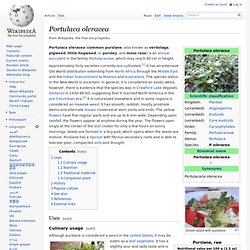
Approximately forty varieties currently are cultivated.[1] It has an extensive Old World distribution extending from North Africa through the Middle East and the Indian Subcontinent to Malesia and Australasia. Australian Gardener- Beautanicals - Tomatoes. Southernharvest.com.au. Tomatillo. The tomatillo ( Physalis philadelphica ) is a plant of the nightshade family, related to the cape gooseberry , bearing small, spherical and green or green-purple fruit of the same name.

Growing Tomatillo in Australia - sub-tropical climate - Garden calendar and reminders. Tomatillos, Cooking with Tomatillos. Tomatillos are also called "tomate verde" in Mexico (which means green tomato) and are considered a staple in Mexican cooking.
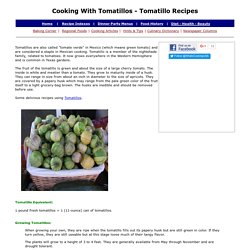
Tomatillo is a member of the nightshade family, related to tomatoes. Tomatillo (Physalis philadelphica syn P. ixocarpa) Tomatillo "Grande Verde" Low growing annual from the Solanaceae (nightshade) family originally from central America.

It grows with an upright habit that becomes increasingly spreading as the smooth 60 -90cm branches are weighed down with developing fruit. The 5cm long, dark green leaves have between two and six 8mm “teeth” along their jagged edges. Callendar (when to plant)
Methods of Plant Propagation. Asexual propagation is the best way to maintain some species, particularly an individual that best represents that species.
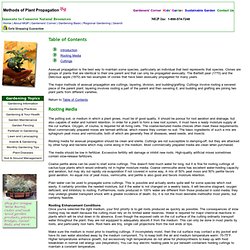
We Grow Your Own – Organic, Local & Fresh. Walter Reeves: The Georgia Gardener. 10 Steps to a Giant Pumpkin – by Don Langevin Taken from For many of us, fall means a bounty of pumpkins for pies and jack-o’-lanterns, along with a gathering in of the rest of the autumn harvest.

But for thousands of backyard gardeners, fall is the time of reckoning and – for a lucky few – glory. How to Grow Big Garlic. Top Ten Tips for Giant Sized Allium Bulbs!
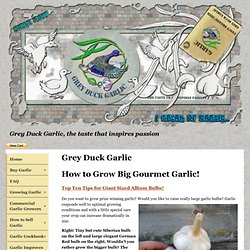
Do you want to grow prize winning garlic? Would you like to raise really large garlic bulbs? Garlic responds well to optimal growing conditions and with a little special care your crop can increase dramatically in size. Right: Tiny but cute Siberian bulb on the left and large elegant German Red bulb on the right. Tomatoes - Fact sheet. Pete gives some tomato planting hints There are few plants that go into the ground quicker than tomatoes.
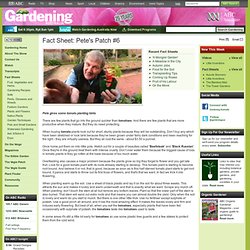
And there are few plants that are more productive when they mature. But they do need protecting. Gardening Australia - Fact Sheet: Nematodes. Jerry shows how to identify and deal with a hidden garden pest Presenter: Jerry Coleby-Williams, 04/04/2009 SERIES 20 Episode 10 A single teaspoon full of well-composted soil can contain hundreds of thousands of different species of organism and up to half a kilometre of fungal threads.

Root knot disease and its control - root-knot-disease.pdf. TOMATO ROOT NEMATODES. From the March 11, 2012 Newsletter issued from Hacienda Chichen Resort beside Chichén Itzá Ruins, central Yucatán, MÉXICO TOMATO DISASTER My glorious tomato vines, now over seven feet high, (2m) are dying. You can see what one vine looks like above. I knew I had trouble two weeks ago when suddenly the vines' upper leaves wilted as if the plants needed watering, though I watered them well each day. Last week the vines' lowest leaves began turning yellow, then quickly became dry and brown, and began falling off.
Now all the leaves on the vines' lower half are dead and it's clear that the whole vines soon will die. Tomato plants are subject to various wilting diseases, so on the Internet I studied their symptoms closely. Tomato Grower's Guide: What Are Nematodes? What is it? Nematodes of many different species infect tomato plants. These nematodes are a microscopic worm which live in soil, however, they are not in any way related to the well-known earthworm. Some forms of nematodes are highly beneficial to tomato plants, while others can wreak total destruction on tomato plants in the garden.
Tomato plant nematodes are prevalent throughout the United States, but they are most damaging to tomato plants in the Southern regions of the United States. Nematode Management Guidelines. UC IPM Home > Homes, Gardens, Landscapes, and Turf > Nematode Nematodes are microscopic, eel-like roundworms. The most troublesome species in the garden are those that live and feed within plant roots most of their lives and those that live freely in the soil and feed on plant roots. My Tomato Plant Dies & Has Numerous Nodules or Swellings on Roots. Help Pollinate Your Tomato Plants. March 20th, 2010 Email 36 users recommend Tomato plants are self-pollinating and have "perfect" flowers.
Photo by Ali Graney under the Creative Commons Attribution License 2.0. Giving your tomato plants a little daily shake will help produce more fruit. Photo by Deb Roby under the Creative Commons Attribution License 2.0. Corn suckers. Growing sweet corn in the backyard garden. By Robert Cox, Colorado State University Cooperative Extension horticulture agent Ask a gardener about the real reason to grow a garden and you'll likely get a two-word answer: Sweet corn. Though corn requires plenty of space in the vegetable garden, it is hard to beat its taste and tenderness, especially when freshly-picked. The key to high quality sweet corn is rapid growth, adequate soil moisture and nutrients, and harvesting the ears at optimum maturity.
Sweet corn kernels can be yellow, white, or both of these colors on the same ear (bicolor). The level of sucrose (sugar) in the kernels determines the corn's sweetness. Ho-98.pdf (application/pdf Object) Building a Worm Farm in a Bathtub. Building a cheap but effective worm farm in a bathtub is a great idea if you also have an aquaponics system or a vegetable garden close by. The fish can always benefit from a tasty snack of live worms.
How do I… Start composting at home? Turning your rubbish into something useful is about as basic as sustainable living gets. Untitled. Homemade Worm Farm. Advanced Household Worm Farming. Soil Preparation - Everything you need to know. Soil preparation is one of the most important steps to having a successful vegetable garden. The best garden soil is fertile, well drained yet retains moisture, and gets enough air circulation which is needed for healthy roots. Find more information on what are your soil types. Early spring is the time to start preparing your soil. Acidifying soil. Acidifying garden soil will lower its pH so that ericaceous plants such as camellias, blueberries, heathers and rhododendrons can grow. How to build a raised vegetable garden bed Vegetable Garden Layout, Vegetable Garden Design, Vegetable Garden Planning.
Free worksheets for planning a vegetable garden layout for a raised bed, square foot, or traditional backyard garden. BROADBENT'S GARDEN SUPPLIES. DIY, Kits and Ideas for Raised Vegetable Gardens. Gardening in the Home Landscape: Designing a Raised Bed Vegetable Garden: 11 Things to Think About. How To Make a Raised Bed Garden - Raised Bed Gardening. Raised Garden Beds - How to Build and Install a Raised Garden Bed. Garden.
Concrete Block Calculator - Quantity Estimator for 200 Series Concrete Blocks. Nature strips: How to go native. Alphabetically list of Vegetables - Every thing you need to know. Walter Reeves: The Georgia Gardener. What happens to Asparagus plants during the Summer? #GardenCuizine @EatRight.